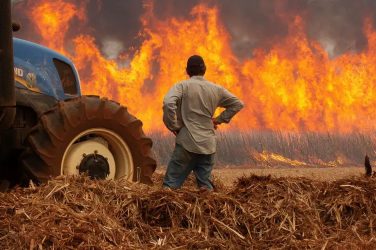In 2015, the collapse of mining company Samarco’s dams at a mine in Mariana, in the Brazilian state of Minas Gerais, caused environmental damage that was unprecedented in the country.
Tons of mud with heavy metals — its volume originally estimated at some 25,000 Olympic-sized swimming pools — stretched over 800 kilometers and reached the Doce River ( “Doce” means “sweet” in Portuguese), one of the most important of Brazil’s major rivers.
The disaster, which had irreversible negative effects on human health and the environment and marked the country’s history, was revived this year in one of the most important spaces in Brazilian popular culture: the Carnaval of Rio de Janeiro.
The winner of Rio’s Carnaval parade, the samba school Portela, chose rivers as its theme — because, it said “many stories pass through them and they keep the secrets of the waters that gave birth to the world”.
In one of the floats, with the title “a river that was sweet”, the samba school abandoned the typical strong colors of the Carnaval and used brown in memory of the tragedy in Minas Gerais. A giant figure of a fisherman, in the color of mud, represented the lament over all that was lost in the disaster.
“It is impossible to talk about rivers without thinking about the violence that was the disaster in the Doce River”, said Isabel Azevedo. Azevedo is a science communicator who works at House of Science, a hands on science center at the Federal University of Rio de Janeiro, and one of the authors of Portela’s parade script.
Another samba school, Imperatriz Leopoldinense, presented the samba script “Xingu, shout that comes from the jungle” to speak to how the indigenous people of the Xingu (who inhabit the first indigenous reserve created in 1961 in Mato Grosso state) contribute to Brazilian culture, and convey a message of conservation and respect toward nature and biodiversity.
Nobel Prize winning chemist Roald Hoffmann, a professor at the Cornell University in the United States, is enthusiastic about the initiative communicating science at the Carnaval.
He told SciDev.Net: “The environment, the earth around us and how we affect and interact with it, is an essential concern to us. And a delight. And science too. It’s natural that we should be curious about the world within and around us. What fun it is to know! It makes great sense that Carnaval, which celebrates life in all its aspects, should look at science and the environment.”
In a note published on its website, the Movement of the People Affected by Dams (MAB, in Portuguese), an organization in Brazil that brings together populations threatened or affected by dams, congratulated the two samba schools:
“What they showed in [the avenue] Sapucaí strengthens the condemnations we systematically make about human rights violations and environmental destruction caused by irresponsible companies, which only seek to benefit where they build these structures.
“Many people think that Carnaval is just a party, but it is also an opportunity to present a critical look at issues that concern us, in a popular expression and with a global dimension, since the Rio Carnaval is seen by approximately 200 countries,” said Azevedo.
The Rio Carnaval has also been, for more than a century, a stage to express social and political criticism through music, costumes and parades.
This article was produced by SciDev.Net’s Latin America and Caribbean edition – http://www.scidev.net












